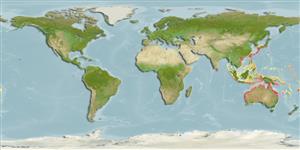Common names from other countries
Environment: milieu / climate zone / depth range / distribution range
पारिस्थितिकी
समुद्री ड़िमरसल; गहराई सीमा 1 - 10 m (Ref. 86942). Temperate
Western Pacific: Sagami Bay and Nagasaki Prefecture, Japan southward to China. Also reported from New Caledonia (Ref. 9070) and Australia (Ref. 7300).
आकार / वज़न / Age
Maturity: Lm ? range ? - ? cm
Max length : 10.0 cm TL पुल्लिंग / अलिंग; (Ref. 559)
पृष्ठीय रीढ़ (सम्पूर्ण): 13 - 14; पृष्ठीय सौफट रेज़ (सम्पूर्ण): 11-15; गुदा कांटा 1; ऐनल सौफट रेज़: 11 - 14. Body almost black and covered with velvety prickles. Preopercle with 5 blunt spines. Attains 10 cm TL.
Occurs in inshore waters of the continental shelf (Ref. 75154). Inhabits sandy or mud bottoms in shallow waters (Ref. 559 and 637). Neither anterolateral glandular groove nor venom gland is present (Ref. 57406).
Life cycle and mating behavior
परिपक्व अवधि | पुनरुत्पत्ति | मछलीऔ का अंडे देना | अंडे | Fecundity | लार्वा
Masuda, H., K. Amaoka, C. Araga, T. Uyeno and T. Yoshino, 1984. The fishes of the Japanese Archipelago. Vol. 1. Tokai University Press, Tokyo, Japan. 437 p. (text). (Ref. 559)
IUCN Red List Status (Ref. 130435)
CITES (Ref. 128078)
Not Evaluated
Threat to humans
Harmless
Human uses
अधिक जानकारी
आम नामउपशब्दचपायचयपरभक्षीईकोटोकसीकोलौजीपुनरुत्पत्तिपरिपक्व अवधिमछलीऔ का अंडे देनाFecundityअंडेEgg development
संदर्भजलीयकृषिजलीयकृषि रूपरेखाखींचआनुवंशिकीElectrophoresesहैरेटिबिलटीबीमारीप्रक्रमणMass conversion
सहयोगीयोतस्वीरेStamps, Coins Misc.ध्वनिसिगुयटिरारफ्तारतैरने के प्रकारगिल क्षेत्रOtolithsदिमागदृष्टि
साधन
Special reports
Download XML
इंटरनेट स्रोत
Estimates based on models
Preferred temperature (Ref.
115969): 21.5 - 28.4, mean 26.7 (based on 903 cells).
Phylogenetic diversity index (Ref.
82804): PD
50 = 1.0000 [Uniqueness, from 0.5 = low to 2.0 = high].
Bayesian length-weight: a=0.00389 (0.00180 - 0.00842), b=3.12 (2.94 - 3.30), in cm Total Length, based on all LWR estimates for this body shape (Ref.
93245).
Trophic level (Ref.
69278): 3.4 ±0.5 se; based on size and trophs of closest relatives
Fishing Vulnerability (Ref.
59153): Low vulnerability (10 of 100).
